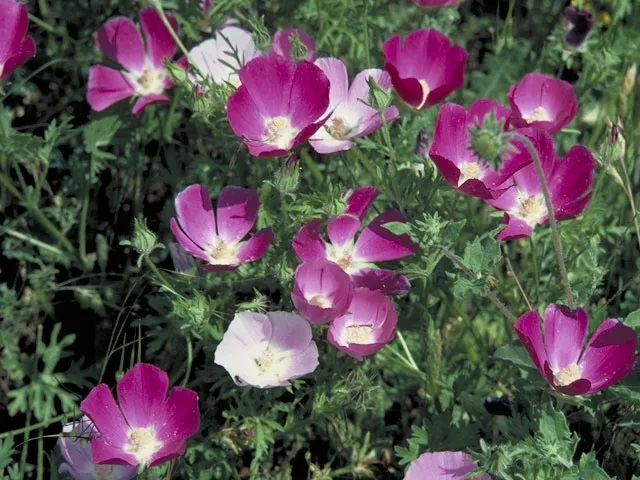NICE! Plant of the Month
(Callirhoe involucrata)

Family: Malvaceae (Mallow)
Other Common Names: Poppy-mallow; Spreading winecup
Type: Perennial
Natural Habitat: throughout Texas except far West Texas
Growth: 6 to 12 inches with some 18-inch trailing stems in a low-growing mound. Tuber with green rosette in winter.
Preferred Site and Use: Open places, roadsides, thickets, hillsides. Use as mass planting.
Deer Resistance: Deer will browse them. Protect with a product such as Liquid Fence.
Wildlife: Butterflies, bees.
Light Tolerance: Dappled shade, part shade, full sun.
Flowers: In April and May. Goblet shaped, with 5 reddish-purple petals that are 1 inch long and finely toothed or fringed on the blunt ends. The lineariloba variety of winecup is white with pink streaks.
Fruit: forms a small disk divided into ten segments each holding a seed
Leaves: Hairy, palmately-veined, deeply cut into 5 to 7 lobes on long stems.
Water Requirements: low
Soil Requirements: well-drained sand, loam, clay, caliche; acid or calcareous.
Maintenance: none
Planting Instructions: Space plants 2 feet apart. Dig a hole at least two times wider than, but the same depth as the root ball in the nursery container. Sides of the hole should be irregular, not smooth. Remove plant from container, taking care to support the root ball. Loosen exterior roots gently with your fingers. If the plant is root-bound and cannot be loosened by hand, the outer roots may be cut in several places. Lift the plant by the root ball and place into the hole. Backfill hole, using soil that was dug out. Do not add any soil to the top of the root ball, but a thin layer of compost may be spread over the soil surface. Gently firm the soil with your hands, but do not tamp it down. Mulch may be added over the bare soil around, but not touching the base of the plant.
Watering Instructions: Water deeply after planting to settle soil around roots. Then water as needed to establish. Water monthly only during periods of drought. Once established, natives will survive with little supplemental irrigation.
NICE! Tip: Winecups are attractive on rocky slopes or spilling over a wall.
Look for the NICE! Plant of the Month signs and information sheets on your next visit to a participating Boerne nursery. And thank you for supporting native plants by using them in your landscapes.

